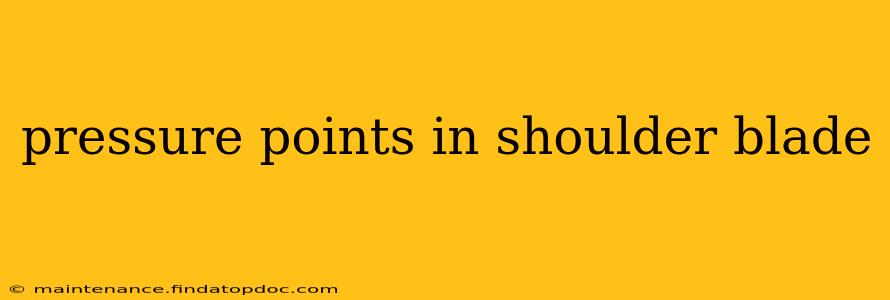The shoulder blade, or scapula, is a complex area with numerous muscles, nerves, and ligaments. Pain in this region can stem from various sources, often manifesting as pressure points. Understanding these pressure points and their potential causes is crucial for effective pain management. This article will delve into common pressure points in the shoulder blade, their causes, and potential relief methods. We'll also address some frequently asked questions about this often-overlooked area of the body.
What Causes Pressure Points in the Shoulder Blade?
Pressure points in the shoulder blade aren't always distinct anatomical points like those used in acupressure. Instead, the sensation of pressure often arises from underlying issues affecting the muscles, nerves, or joints surrounding the scapula. Common causes include:
-
Muscle Strain or Spasm: Overuse, poor posture, or sudden movements can lead to muscle strain or spasms in the trapezius, rhomboids, levator scapulae, and other muscles around the shoulder blade. This muscle tension creates localized pressure and pain.
-
Referred Pain: Pain originating from another area of the body, such as the neck, heart, or even the diaphragm, can be felt as pressure in the shoulder blade. This is known as referred pain and requires investigation to identify the primary source.
-
Injury: Direct trauma to the shoulder blade, such as a fall or impact, can cause fractures, dislocations, or soft tissue injuries leading to pressure points.
-
Arthritis: Osteoarthritis or rheumatoid arthritis affecting the shoulder joint or the spine can lead to inflammation and pressure in the shoulder blade region.
-
Nerve Compression: Compression or irritation of nerves in the neck or shoulder can radiate pain felt as pressure in the shoulder blade area. This is common in conditions like thoracic outlet syndrome.
Where Are the Common Pressure Points in the Shoulder Blade?
Pinpointing the exact location of pressure is subjective, varying based on individual anatomy and the underlying cause. However, many people experience pressure sensations in these general areas:
-
Upper Trapezius: The upper portion of the trapezius muscle, running from the base of the skull down to the shoulder blade, is a frequent source of pressure and tension.
-
Rhomboid Muscles: Located between the shoulder blades, these muscles are often implicated in upper back pain and pressure sensations.
-
Levator Scapulae: This muscle connects the neck vertebrae to the top of the shoulder blade and often contributes to shoulder and neck tension.
How Can I Relieve Pressure Points in My Shoulder Blade?
Several approaches can help relieve pressure and pain in the shoulder blade:
-
Self-Massage: Gentle massage of the affected muscles can help relieve tension. Focus on the areas where you feel the most pressure.
-
Heat or Ice: Applying heat packs or ice packs to the area can help reduce pain and inflammation. Experiment to see which works better for you. Heat is often preferred for muscle tension while ice is better for acute injury.
-
Stretching: Regular stretching exercises for the shoulder, neck, and back can improve flexibility and reduce muscle tightness.
-
Over-the-Counter Pain Relief: Non-steroidal anti-inflammatory drugs (NSAIDs) like ibuprofen can help reduce pain and inflammation.
-
Professional Help: If pain is severe or persistent, consult a doctor or physical therapist. They can provide a proper diagnosis and recommend appropriate treatment, which might include targeted therapies like physiotherapy or chiropractic adjustments.
What Are Some Stretches for Shoulder Blade Pain?
Several stretches can help alleviate pressure in the shoulder blade area. These include:
-
Shoulder Blade Squeeze: Sit or stand tall and squeeze your shoulder blades together, holding for a few seconds before releasing.
-
Cross-Body Shoulder Stretch: Gently pull one arm across your body, holding it at the elbow with your opposite hand. This stretches the muscles of the upper back and shoulder.
-
Neck Rotations: Slowly rotate your head from side to side, gently increasing the range of motion as your muscles loosen.
-
Thoracic Rotations: Gently twist your torso from side to side, holding each rotation for several seconds. This helps to improve mobility in the upper spine.
Is Shoulder Blade Pressure a Sign of Something Serious?
Shoulder blade pressure itself isn't necessarily a sign of something serious, but it can indicate an underlying condition. If the pressure is accompanied by other symptoms like numbness, tingling, weakness, or severe pain, it's crucial to seek medical attention. The doctor can diagnose the cause and recommend the appropriate treatment.
When Should I See a Doctor for Shoulder Blade Pain?
Consult a physician if:
- Your pain is severe or persistent.
- You experience numbness, tingling, or weakness in your arm or hand.
- You have a history of heart conditions.
- Your pain is accompanied by fever or unexplained weight loss.
- Over-the-counter pain relief does not alleviate your symptoms.
By understanding the potential causes and relief methods for pressure points in the shoulder blade, you can take steps towards pain management and improved well-being. Remember, if you're experiencing persistent or concerning symptoms, seeking professional medical advice is paramount.
